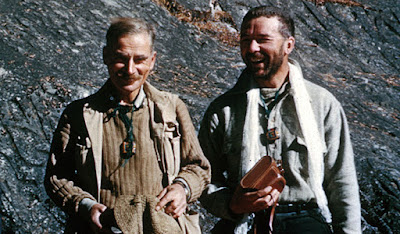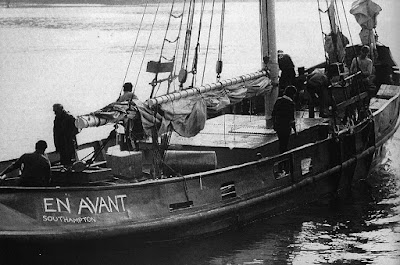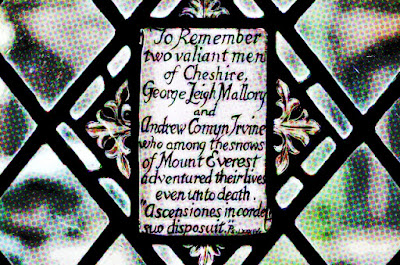Original Photo: Sandy Lee
When Bill Tilman was lost in the stormy South Atlantic seas in 1977, with the entire crew of the the En Avant, en route to Smith Island, where several of the crew intended to launch a mountaineering expedition, the world lost a remarkable adventurer and irrepressible free spirit. In his 80th year, an age when most people-even those with a climbing and sailing background-have gracefully retired from the activity and content themselves with books and gardening, Tilman found it impossible to let go of the reins. Pushing his elderly body as far as possible. Never for one moment entertaining the possibility that he could not still play a hand’s on roll on an expedition.
Now Vertebrate Publishing-best known as one of the UK’s premier mountaineering book publishers, have teamed up with sailing publishing house, Lodestar Books- to bring Tilman’s adventure books back into the spotlight. With over half of the reprint run already in the bookshops, its a good time for those unfamiliar with this fascinating and iconic figure from the world of mountaineering and ocean sailing, to acquaint themselves with the Tilman oeuvre.

Born at the very end of the 19th century, just as Queen Victoria was leaving the stage, the Merseysider who was born in Wallasey on the Wirral was the son of a successful sugar merchant. Tilman would have looked out to the Liverpool docks across the busy waterway, where he would see the commodity which funded his somewhat privileged life, unloaded into the great warehouses which lined the then thriving Liverpool docklands. Perhaps it was being born at the mouth of a great river which stimulated an interest in all things nautical?
Sent off for a private education at Berkhamstead, after completing his education, the young Tilman soon found himself caught up in the carnage of the first world war. Surviving amongst other campaigns, the battle of the Somme. Ten years after the war, Tilman met up with Eric Shipton who like himself was engaged in the coffee trade of East Africa. Early forays upon Mount Kenya, Kilimanjaro and Ruwenzori cemented a highly successful and long lasting climbing partnership.
Between the wars,Tilman was involved in two of the 1930s Mount Everest expeditions. The 1935 Reconnaissance Expedition, and as leader of the 1938 expedition when he reached 27200 feet without oxygen. With Shipton, he ventured into the previously unexplored Nanda Devi sanctuary in 1934 and two years later he returned and led a UK/US expedition which mounted a successful attempt on the summit. A mountain which until 1950, remained the highest yet climbed.

Despite his age, Tillman volunteered for service in the WW2 and served in North Africa and Dunkirk. Later in the campaign he saw action behind enemy lines and fought with Albanian and Italian partisans in their bloody campaign in southern Europe and was awarded the DSO for his sterling work with the partisans.
After the war and now approaching his 50‘s, he began an impressive ocean sailing career to which complimented his mountaineering activities by enabling him to visit far flung and previously inaccessible areas. Initially setting sail in his famous Pilot Cutter ‘Mischief’ and visiting the Arctic regions and several remote Atlantic and Pacific islands, Tilman went on to skipper two more pilot cutters; ‘Sea Breeze’ and ‘Baroque’, before setting out on his fateful final voyage as a crew member of the Simon Richardson skippered ‘En Avant’.
With regard to the ill fated vessel, its worth quoting from a Yachting and Boating forum where a contributor’s diligent research had turned up the following information.....

“En Avant was a wartime tugboat hull constructed by slave labour. She was a semi-wreck and had been sunk more than once, Richardson himself fitted a Deutz marine engine, large battery banks and a welded keel. She had good stability but low freeboard. There have been differing views of the boat, Colin Putt wrote: "En Avant proved to be a good sea boat and the crew turned up trumps" elsewhere she was described as a "sorry sight" and was thought to be unsuitable for the trip. Conditions on board would have been stark.
I suspect the trip was funded by Richardson's own resources perhaps with contributions from the crew. He bought the boat for £750 and was given the engine. He was keen on Tilman's concept of small, low cost, expeditions. His Mother's writings (which I have not seen) would no doubt flesh this out.....There were seven on the trip: Tilman, Richardson, Coatman, Toombs, Williams (contacted by advert), Johnson (old school friend) and Dittamore (American Climber)....I guess some of the three brought in by advert would be sailors.’.

Bill Tilman spent the last 30 years of his life here in North Wales.Living in the beautifully situated traditional stone country house of Bod Owen, above the Malltraeth Estuary near Barmouth in Gwynedd.Ironically, a quiet and peaceful stretch of water compared to the incomparably wild and stormy waters of the South Atlantic which took his life.
The Adventure Archive..
1929: Tilman is introduced to rock climbing in the Lake District of England.
1930: He ascends Mawenzi and almost ascends Kibo on Kilimanjaro, with Eric Shipton.
1930: He makes first ascent of West Ridge of Batian, and traverses to Nelion, with Shipton.
1932: Tilman ascends Mounts Speke, Baker, and Stanley in the Ruwenzori Range, with Shipton.
1932: In April, he is involved in an accident in the Lake District which leads to the death of J. S. Brogdon.
1932: Later that year, he makes various climbs in the Alps.
1933: Tilman ascends Kilimanjaro (to summit) alone.
1934: Tilman and Shipton, with three others, make the first recorded
entrance into the Nanda Devi Sanctuary. They also explore the nearby
Badrinath Range.
1935: Tilman unable to acclimatise on the Mount Everest
Reconnaissance Expedition led by Eric Shipton, but climbs various
20,000 ft. peaks in the Everest region.
1936: Tilman attempts various peaks and passes, including the Zemu
Gap, in Sikkim, near Kangchenjunga. Later, he leads the first ascent of
Nanda Devi.
1937: Shipton and Tilman make a major reconnaissance and surveying expedition in the Karakoram.
1938: Tilman leads another Mount Everest Expedition; he and three others reach above 27,300 ft (8,320 m) but fail to reach the summit.
1938: He traverses the Zemu Gap.
1939: He leads an expedition in the remote Assam Himalaya, which
ends in disaster. They attempt Gori Chen, but reach only the lower
slopes. The party was ravaged by Malaria, causing the death of one
member.
1941: Tilman climbs various peaks in Kurdistan.
1942: He makes a night ascent of Zaghouan, in Tunisia.
1947: Tilman leads an attempt on Rakaposhi which explores five
different routes, none of which get near the summit. The expedition then
explored the Kukuay Glacier on the southwest side of the Batura
Muztagh.
1947: He attempts Muztagh Ata, with Shipton and Gyalgen Sherpa.
1948: Tilman attempts Bogda Feng, in northern Xinjiang, with Shipton and two others, but they only reach outlying summits.
1948: He attempts Chakragil, in western Xinjiang.
1948: He travels in the Chitral area of the Hindu Kush.
1949: Tilman leads a four-month exploratory and scientific
expedition to the Langtang, Ganesh, and Jugal Himals in Nepal, in the
early stages of that country's re-opening to outsiders. He climbs Paldor
in the Ganesh Himal.
1950: He leads the British Annapurna Expedition, which gets close to
the summit of Annapurna IV, and attempts other nearby peaks.
1950: Tilman and Charles Houston view Mount Everest from the lower
slopes of Pumori, on the recently opened Nepalese side of the peak.
1955 – 12 months, 20,000 miles: First voyage in Mischief. Together with Jorge Quinteros he performs the first longitudinal crossing of the Southern Patagonian Ice Field.
1957 – 12 months, 21,000 miles, circumnavigation of the African continent
1959 – 12 months, 20,000 miles, South Atlantic, Iles Crozet
1961 – 4 months, 7,500 miles, West Greenland - Upernavik region
1962 – 4 months, 6,500 miles, West Greenland and Baffin Island
1963 – 4 months, 7,000 miles, Bylot Island, Baffin Bay
1964 – 4 months, 3,700 miles, East Greenland
1964 – 5 months, 10,000 miles, skippering the schooner Patanela to Heard Island in the Southern Ocean
1965 – 4 months, 4,000 miles, East Greenland - Return visit
1966 – 12 months, 20,400 miles, Islands of the Southern Ocean
1968 – 3 months, 2,500 miles, East Greenland, Jan Mayen, Loss of Mischief
1969 – 4 months, 3,400 miles, first voyage in Sea Breeze - East Greenland
1970 – 4 months, 5,000 miles, South West Greenland - Faeringehavn, Julianhaab, Nanortalik, Torsukatak
1971 – 4 months, 5,000 miles, Faroe Islands, Iceland, East Greenland - Angmassalik
1972 – 3 months, 3,000 miles, East Greenland, Loss of Sea Breeze
1973 – 4 months, 5,000 miles, First voyage in Baroque, to West Greenland.
1974 – 4 months, 7,000 miles, circumnavigation of Spitzbergen
1975 – 4 months, 5,000 miles, West Greenland
1976 – 4 months, East Greenland - Angmagssalik - Reykjavik
1977 - 1 month, Reykjavik-Lymington
1977 – 4 months (?), Carried as crew/navigator on Simon Richardson's En Avant
from Southampton to Las Palmas then Rio de Janeiro. Vessel presumed
lost at sea on route to the Falkland Islands with loss of all hands.
Source WikiPedia
John Appleby:2016
The Tilman Series of adventure books are available from Vertebrate Publishers.
Tilman Archive: Yachting and Boating forum

I suppose a solid week of rain and gales can make even the most hardened of the rain dancing pub dwellers wish for a bit of sunshine. If only in order to remain dry between car and bar. After all, it is possible to spend an entire day in the Old Dungeon Ghyll starting in the snacks and soft drinks end at 9 a.m. (does anyone really crawl out of their tent that early) moving to the bar at the stroke of eleven and back to the snacks for the brief respite from 3.10 till 5 p.m. After a week of these conditions, Friday morning produced some change in that it managed to rain even harder and we were on the verge of becoming totally insane, irretrievably alcoholic, or both. Something had to be done rain or not. Leaving the bar shortly after midday (after all we do have to pay our respects to the brewery) amid the usual flurry of ribald and colourful remarks, we headed for Stool End just as the downpour turned on an extra violent display.
One or two well waterproofed early risers looked a little surprised to see anyone starting up the hill at that late hour (for them anyway) especially after a morning during which conditions had degenerated from worse to much worse. Nevertheless we were greeted cheerily, no doubt because they were on their way to dry warm surroundings such as we had recently vacated. Rick set a cracking pace up the Band and it was not long before I cracked and allowed the gap between us to widen, settling down to a steady, head down plod, which allowed the rain to drip from my cagoule hood to the ground instead of coursing down my nose and eventually trickling down my neck. By the time we turned off the main path to head for the Climbers' Traverse he was almost out of sight and soon disappeared over the ridge. I stopped briefly to see what it felt like not to be heaving for breath, then struggled on to reach the high point. Sensing relief at the thought that the next section was more or less level. No sign of Rick. Another brief respite, then making a much better pace I managed to catch him as he stopped to examine the dripping walls of Flat Crags.
Bowfell Buttress itself was by turns hidden or visible as banks of cloud swirled up and down the gullies and cascaded over the top like a silent, ghostly waterfall. And still it rained. Once ,at the foot, we exposed the ropes and assorted gear to the elements and made haste to get started before we had time to cool off. My one previous acquaintance with Bowfell Buttress had been in glorious weather four years previously and I had climbed, unethically I feel, in PA’s. This time Rick was in a pair of very bendy army type boots- of dubious origin- matched by my worn out, loose soled ‘leakies’. Both in full waterproofs (at least, that's what equipment dealers sell them as) and carrying sacs with us. All we needed were Alpenstocks and Edward Whymper would have been proud of us.

As I was tied to the rope ends which came from the top of the now soggy heaps, I took first lead up what should have been easy rock to the foot of the chimney. Every reach upwards produced an uncomfortable trickle down the sleeve of my Kag and every flat or slightly hollowed hold contained a puddle which froze the fingers and improved the flow of water down my arms. The footholds could be likened to miniature skating rinks so it was some relief to find the chimney relatively dry. "I'll carry on Rick," I said, dropping a tape runner over a large block. His face was a study of wet, cold misery, huddled at the foot, paying out soggy rope through frozen fingers. I moved up, jammed myself in and struggled, gaining height by inches rather than feet. The exit right at the top proved extremely awkward since I was unable to reach a large hold, and every time I moved up, my sac jammed under the overhang at the top of the left wall.
Five minutes later more squirming and heaving had generated considerable warmth and enough progress to allow a step right, then up to the large terrace. And once more into the driving rain. "Alright whose silly idea was this anyway?" A "Thank Gawd" look spread across Rick's face as I called for him to climb. He made short work of the first bit and used his height and reach advantage to make the chimney look easy before accepting some ironmongery for use on the next pitch. I watched with growing apprehension as Rick normally leads several standards above mine and was spending some time making moves up the first steep wall. Eventually he disappeared around a corner on the left and seemed, to be climbing steadily. Occasionally the chink and click of karabiners drifted down through the rain and mist till I soon called that there was only ten feet of rope left. No reply. A lung splitting shout prompted an answer, rather muffled, but to the effect that he was about to belay.
I had to assume that the next call from above as the rope tightened meant that I could start and quickly discovered why the little wall had proved awkward. Two steps up on sloping wet foot holds with nothing much for the hands, followed by a tricky move right to a small ledge then better holds to traverse up to the left and round the corner into an open chimney-groove cum watercourse. A doddle in P.A.s but in these conditions it took me some time to reach the comparative security of the watercourse. Thirty feet of this led to a large runner and the rope vanishing round to the right over easy ground. ,Rick was belayed at the bottom of a vertical, ten foot crack that formed the start of the next pitch. I studied it, unconvinced of my ability to lead in the prevailing conditions. Two attempts were enough and I more or less slid back down. Hanging on to the sling from a chock jammed high in the crack as part of the belay.
"We'll be here all day if I keep at this," I said, "you have a go." Gear was exchanged and in a matter of minutes Rick once again vanished from view. With only a few feet of rope left movement ceased. A moment or two of delay then a voice from the clouds, "Right, when you're ready." Confidence in the top rope improved the appearance of the crack no end and in spite of one boot sliding from a greasy foothold, I was soon up and following the rope away to the left. This proved to be the wrong line, forcing me into a difficult and slippery step round on to a sloping ledge to regain the route. Easy climbing from here led to a short wall with a Chimney in the corner to its left. I ascended the wall on good holds to a narrow ledge which ended some feet from the Chimney from where the step across looked decidedly nasty.
A very long, blind, off balance stride to a slimy unseen foothold. Easy in the dry but with rain still bucketing down-and in bendy boots- quite intimidating. I was glad to have avoided leading that. Sixty easy feet to go, I accepted the sharp end and made quick work of yet another chimney and easy groove that trended to the left and easy ground. As Rick arrived the heavens decided on a final fling and pelted us with fair sized hailstones for some minutes before easing away to nothing. Just another bit of amusement for us as we coiled the ropes. "Oh for a pint !" Scrambling to the top of the ridge we were rewarded for our efforts by a remarkable sight. The clouds had lifted and were scudding just above the top of Bowfell on our left and looking underneath them towards the coast, we could see the line where they ended abruptly. Brilliant sunshine produced an intense silvery reflection from a sea darkened by scattered cloud showers near the shore but quite clear and tending to become almost golden further out. In the distance, the shadowy hump of The Isle of Man stood out beneath the final ridge of Scafell.

Image: The Old Dungeon Ghyll
What a superb way to finish a climb we thought. As we walked over Bowfell summit and down towards the Band, the rain ceased completely and a patch of blue widened above us. "Well," Said Rick, "I think that's done it, we've frightened the weather off." And indeed we had. Saturday and Sunday provided us with two excellent days climbing. But that's another story before which we had an appointment with a pint glass and some dry clothing. A worthwhile day? Yes definitely. Under these conditions Bowfell Buttress gets my five star rating for a fine mountaineering route.
Tony Sainsbury: First published as 'A Worthwhile Day'in Climber and Rambler-September 1977

Ever since the mountain was first attacked in 1922 Everest has taken its toll of human lives. Of course everyone interested in the history of Himalayan climbing knows that the summit bid made by Mallory and Irvine on June 8th 1924 ended in disaster. I should expect an educated young climber to be able to tell me something about Mallory: I should be astonished if any information were forthcoming about Irvine. Not so now that the Irvine diaries and his biography have been published. Before it would hardly have been wrong to call Irvine "the unknown Everester". Now on Everest's roll of honour he can occupy the place he deserves. With hindsight one can see that the years between 1919 and 1925 were not the best of times to launch attempts to climb Everest.The climbing world of those days was very small and the number of experienced mountaineers of the right age had been heavily cut down by the blood bath of the 1914-18 war.
Passages by sea made it necessary for a man to get leave of six to eight months from his home and many ‘possibles’ could not do this, nor could they have afforded it had the leave been given. Thus the 1924 expedition started out with only eight climbers....in 1953 there were 14. about high altitude climbing we then had almost everything to learn; as an example, i remember Captain Farrah saying to me in 1920 that he thought that four climbers on an expedition would be a big enough team to make an effective dash for the top.
One had to admit that the pioneer climbs on Everest had two major results. first,they set foot on great controversy about the use of oxygen on high altitude climbs. At first, most mountaineers were against it. this certainly applies to the climber on the 1922 and 1924 expeditions.

Irvine's former home in Birkenhead.After falling into dereliction it has since been restored and converted into apartments
in 1922 Finch was the chief advocate of oxygen but he was a voice crying in the wilderness; none of the experienced mountaineers wanted to go with him but Geoffrey Bruce did not mind because he was a mountaineer and was game for adventure. secondly, there was an undoubted influence of Everest on expanding the interest in climbing; you might almost say, it was the spark which set the world alight. the selection committee in 1923 were in two minds about including Irvine on the team for 1924. some held the view that he was too young. But Irvine’s supporters had three strong argument in his favour.
First he was a very fine athlete of well proven stamina and splendid strength. Secondly: Noel Odell had been greatly impressed in Spitsbergen (August 1923) with his cheerful devotion to the work of the sledge journey and the dogged determination with which he faced its problems. Odell’s views carried the weight with the pundits in London. Then....and most important of all..Irvine was the right man to be in charge of the oxygen equipment. He was a born engineer and had good workshop experience. he had a keen eye for the solution of practical problems and very skillful hands. None of the others could have done what he did.
The homeland of the Irvine clan in times long past had been in the Scottish lowlands, not far north of the English Border. In the past, one of them had walked south to Liverpool to start a small commercial enterprise. Slowly that business grew. By the time Sandy came on the scene, the family were established in moderate affluence in a nice house in Birkenhead. the sons were sent to Shrewsbury, a school which at the start of the century had on its staff, the best rowing coach in England. When he took up residence in Merton, Oxford in January 1922, Sandy was immediately given a place in the university crew. He was a very fine oarsman indeed.
The speed with which sandy mastered the techniques of racing on skis was to some extent due to his considerable experience of ordinary ski running in Norway and Spitsbergen in 1923. As a mountaineer he was clearly competent above the average for a man of limited experience-the assumption that he had done no previous climbing is quite wrong.

Chester Cathedral Memorial window.Dedicated to its Cheshire born heroes.
At the end of a long life of devotion to the mountains, I look back on so much that has been thrilling and delightful, (though there have been incidents that have given me grief and pain) The days of my active climbing are now long passed. Yet now, in old age, comes a pleasure I never anticipated; the privilege of doing something for the mountain world. For I have revived the memory of an Everester who must not be forgotten. If I may borrow the words from Holy Writ: Andrew Irvine ‘was dead and is alive again; he was lost and is found’.
Herbert Carr: First published in Climber: December 1979














